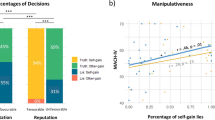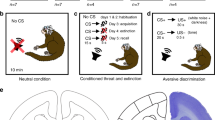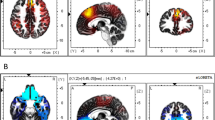Abstract
As decision-making is central to motivated behavior, understanding its neural substrates can help elucidate the deficits that characterize various maladaptive behaviors. Twenty healthy adults performed a risk-taking task during positron emission tomography with 15O-labeled water. The task, a computerized card game, tests the ability to weigh short-term rewards against long-term losses. A control task matched all components of the risk-taking task except for decision-making and the difference between responses to contingent and non-contingent reward and punishment. Decision-making (2 runs of the active task minus 2 runs of the control task) activated orbital and dorsolateral prefrontal cortex, anterior cingulate, insula, inferior parietal cortex and thalamus predominantly on the right side, and cerebellum predominantly on the left side. In an exploratory analysis, guessing (run 1 minus run 2 of the active task) accompanied activation of sensory-motor associative areas, and amygdala on the left side, whereas informed decision-making (run 2 minus run 1) activated areas that subserve memory (hippocampus, posterior cingulate) and motor control (striatum, cerebellum). The findings provide a framework for future investigations of decision-making in maladaptive behaviors.
Similar content being viewed by others
Log in or create a free account to read this content
Gain free access to this article, as well as selected content from this journal and more on nature.com
or
References
Bartzokis G, Lu PH, Beckson M, Rapoport R, Grant S, Wiseman EJ, London ED . (2000): Abstinence from cocaine reduces high-risk responses on a gambling task. Neuropsychopharmacology 22: 102–103
Bechara A, Damasio AR, Damasio H, Anderson SW . (1994): Insensitivity to future consequences following damage to human prefrontal cortex. Cognition 50: 7–15
Bechara A, Damasio H, Damasio AR, Lee GP . (1999): Different contributions of the human amygdala and ventromedial prefrontal cortex to decision-making. J Neurosci 19: 5473–5481
Buchel C, Dolan RJ, Armony JL, Friston KJ . (1999): Amygdala-hippocampal involvement in human aversive trace conditioning revealed through event-related functional magnetic resonance imaging. J Neurosci 19: 10869–10876
Buchel C, Morris J, Dolan RJ, Friston KJ . (1998): Brain systems mediating aversive conditioning: an event-related fMRI study. Neuron 20: 947–957
Critchley HD, Elliott R, Mathias CJ, Dolan RJ . (2000): Neural activity relating to generation and representation of galvanic skin conductance responses: a functional magnetic resonance imaging study. J Neurosci 20: 3033–3040
Damasio AR . (1994): Descartes Error: Emotion, Reason and the Human Brain. New York, G.P. Putnam
de Zubicaray GI, Andrew C, Zelaya FO, Williams SC, Dumanoir C . (2000): Motor response suppression and the prepotent tendency to respond: a parametric fMRI study. Neuropsychologia 38: 1280–1291
Deiber MP, Passingham RE, Colebatch JG, Friston KJ, Nixon PD, Frackowiak RS . (1991): Cortical areas and the selection of movement: a study with positron emission tomography. Exp Brain Res 84: 393–402
Derogatis LR, Rickels K, Rock AF . (1976): The SCL-90 and the MMPI: a step in the validation of a new self-report scale. Br J Psychiatry 128: 280–289
Dolan RJ, Fletcher PC . (1997): Dissociating prefrontal and hippocampal function in episodic memory encoding. Nature 388: 582–585
Doya K . (2000): Complementary roles of basal ganglia and cerebellum in learning and motor control. Curr Opin Neurobiol 10: 732–739
Elliott R, Dolan RJ, Frith CD . (2000a): Dissociable functions in the medial and lateral orbitofrontal cortex: evidence from human neuroimaging studies. Cereb Cortex 10: 308–317
Elliott R, Friston KJ, Dolan RJ . (2000b): Dissociable neural responses in human reward systems. J Neurosci 20: 6159–6165
Elliott R, Frith CD, Dolan RJ . (1997): Differential neural response to positive and negative feedback in planning and guessing tasks. Neuropsychologia 35: 1395–1404
Elliott R, Rees G, Dolan RJ . (1999): Ventromedial prefrontal cortex mediates guessing. Neuropsychologia 37: 403–411
Everitt BJ, Morris KA, O'Brien A, Robbins TW . (1991): The basolateral amygdala-ventral striatal system and conditioned place preference: further evidence of limbic-striatal interactions underlying reward-related processes. Neuroscience 42: 1–18
Friston KJ, Frith CD, Liddle PF, Frackowiak RSJ . (1991): Comparing functional (PET) images: the assessment of significant change. J Cereb Blood Flow Metab 11: 690–699
Friston KJ, Holmes AP, Worsley KJ, Poline JB, Frith CD, Frackowiak RSJ . (1995): Statistical parametric maps in functional imaging: a general linear approach. Hum Brain Mapp 2: 189–210
Frith CD, Friston K, Liddle PF, Frackowiak RS . (1991): Willed action and the prefrontal cortex in man: a study with PET. Proc R Soc Lond B Biol Sci 244: 241–246
Gaffan D, Harrison S . (1987): Amygdalectomy and disconnection in visual learning for auditory secondary reinforcement by monkeys. J Neurosci 7: 2285–2292
Grant S, Contoreggi C, London ED . (2000): Drug abusers show impaired performance in a laboratory test of decision making. Neuropsychologia 38: 1180–1187
Graybiel AM . (1995): Building action repertoires: memory and learning functions of the basal ganglia. Curr Opin Neurobiol 5: 733–741
Heilman KM . (1997): The neurobiology of emotional experience. J Neuropsychiatry Clin Neurosci 9: 439–448
Herscovitch P, Markham J, Raichle ME . (1983): Brain blood flow measured with intravenous H215O. I. Theory and error analysis. J Nucl Med 24: 782–789
Jahanshahi M, Jenkins IH, Brown RG, Marsden CD, Passingham RE, Brooks DJ . (1995): Self-initiated versus externally triggered movements. I. An investigation using measurement of regional cerebral blood flow with PET and movement-related potentials in normal and Parkinson's disease subjects. Brain 118: 913–933
Kawagoe R, Takikawa Y, Hikosaka O . (1998): Expectation of reward modulates cognitive signals in the basal ganglia. Nat Neurosci 1: 411–416
Knutson B, Westdorp A, Kaiser E, Hommer D . (2000): FMRI visualization of brain activity during a monetary incentive delay task. Neuroimage 12: 20–27
London ED, Ernst M, Grant S, Bonson K, Weinstein A . (2000): Orbitofrontal cortex and human drug abuse: functional imaging. Cereb Cortex 10: 334–342
MacDonald III AW, Cohen JD, Stenger VA, Carter CS . (2000): Dissociating the role of the dorsolateral prefrontal and anterior cingulate cortex in cognitive control. Science 288: 1835–1838
Morris JS, Frith CD, Perrett DI, Rowland D, Young AW, Calder AJ, Dolan RJ . (1996): A differential neural response in the human amygdala to fearful and happy facial expressions. Nature 383: 812–815
Nishijo H, Ono T, Nishino H . (1988): Single neuron responses in amygdala of alert monkey during complex sensory stimulation with affective significance. J Neurosci 8: 3570–3583
Owen AM, Doyon J, Petrides M, Evans AC . (1996): Planning and spatial working memory: a positron emission tomography study in humans. Eur J Neurosci 8: 353–364
Paradiso S, Johnson DL, Andreasen NC, O'Leary DS, Watkins GL, Ponto LL, Hichwa RD . (1999): Cerebral blood flow changes associated with attribution of emotional valence to pleasant, unpleasant, and neutral visual stimuli in a PET study of normal subjects. Am J Psychiatry 156: 1618–1629
Raichle ME, Martin WRW, Herscovitch P, Mintun MA, Markham J . (1983): Brain blood flow measured with intravenous H2 15O. II. Implementation and validation. J Nucl Med 24: 790–798
Robins LN, Helzer JE, Croughan J, Ratcliff KS . (1981): National Institute of Mental Health Diagnostic Interview Schedule. Its history, characteristics, and validity. Arch Gen Psychiatry 38: 381–389
Rogers RD, Owen AM, Middleton HC, Williams EJ, Pickard JD, Sahakian BJ, Robbins TW . (1999): Choosing between small, likely rewards and large, unlikely rewards activates inferior and orbital prefrontal cortex. J Neurosci 19: 9029–9038
Rolls ET . (1992): Neurobiological aspects of emotion, memory and mental dysfunction. In Aggleton JP (ed), The Amygdala. New York, Wiley-Liss, pp 143–165
Rolls ET . (1996): The orbitofrontal cortex. Philos Trans R Soc Lond B Biol Sci 351: 1433–1443
Schoenbaum G, Chiba AA, Gallagher M . (1998): Orbitofrontal cortex and basolateral amygdala encode expected outcomes during learning. Nat Neurosci 1: 155–159
Smith EE, Jonides J . (1998): Neuroimaging analyses of human working memory. Proc Natl Acad Sci USA 95: 12061–12068
Talairach J, Tournoux P . (1988): A Co-planar Stereotactic Atlas of the Human Brain. New York, Thieme Medical Publishers
Weiskrantz L . (1956): Behavoral changes associated with ablation of the amygdaloid complex in monkeys. J Comp Physiol 49: 381–391
Woods RP, Cherry SR, Mazziotta JC . (1992): Rapid automated algorithm for aligning and reslicing PET images. J Comput Assist Tomogr 16: 620–633
Zachary RA, Paulson MJ, Gorsuch RL . (1985): Estimating WAIS IQ from the Shipley Institute of Living Scale using continuously adjusted age norms. J Clin Psychol 41: 820–831
Zald DH, Pardo JV . (1997): Emotion, olfaction, and the human amygdala: amygdala activation during aversive olfactory stimulation. Proc Natl Acad Sci USA 94: 4119–4124
Zalla T, Koechlin E, Pietrini P, Basso G, Aquino P, Sirigu A, Grafman J . (2000): Differential amygdala responses to winning and losing: a functional magnetic resonance imaging study in humans. Eur J Neurosci 12: 1764–1770
Acknowledgements
Supported by the NIDA Intramural Research Program, NIH grants DA 11426 (KB) and the JHBMC-GCRC (MO1 RR02719). The Brain Imaging Center of the National Institute on Drug Abuse was developed with funds from the Counterdrug Technology Assessment Center, Office of National Drug Control Policy.
Author information
Authors and Affiliations
Corresponding author
Rights and permissions
About this article
Cite this article
Ernst, M., Bolla, K., Mouratidis, M. et al. Decision-making in a Risk-taking Task: A PET Study. Neuropsychopharmacol 26, 682–691 (2002). https://doi.org/10.1016/S0893-133X(01)00414-6
Received:
Revised:
Accepted:
Issue date:
DOI: https://doi.org/10.1016/S0893-133X(01)00414-6
Keywords
This article is cited by
-
Dynamic causal modeling of evoked responses during emergency braking: an ERP study
Cognitive Neurodynamics (2022)
-
Ordinaries 10
Journal of Bioeconomics (2022)
-
Decision Making: a Theoretical Review
Integrative Psychological and Behavioral Science (2022)
-
Decision-making in primary onset middle-age type 2 diabetes mellitus: a BOLD-fMRI study
Scientific Reports (2017)
-
Are there gender differences in young vs. aging brains under risk decision-making? An optical brain imaging study
Brain Imaging and Behavior (2017)



